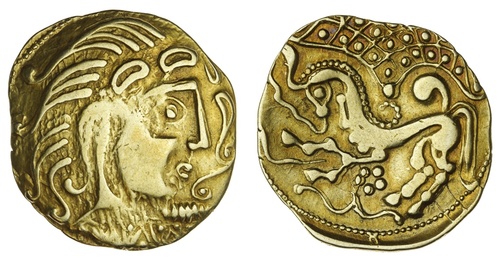
Auction: 382 - The Numismatic Collector's Series Sale at NY INC
Lot: 441
Gaul, Parisii (c. 120-80 BC), Puteaux Hoard Type - de Beaulieu Class V - Sills 'Charenton Camp Payment', 'Wolf-Teeth' AV Stater, stylish Celticised Apollo head right, wearing a necklace of wolf's teeth, rev. horse rearing left with neatly beaded mane and beaded forepart, simulacrum of Charioteer as reticulated netting, cinquefoil of pellets [rosette] and inverted and simplified bucranium beneath front legs, 6.90g, 3h (Gallo-Belgic, Series Xb - 'Bullet Staters'; LT 7777; BN 7777; DT 83; Monique Mainjonet, Revue Numismatique, Series VIe, Vol. IV (Le Trésor de Puteaux [Seine], 1962), pp. 59-72, Pl. III, no. 19 this coin [Dies D3a/7b]; Jean-Baptiste Colbert de Beaulieu, Les monnaies gauloises des Parisii (1970), Fig. 16 [c. 60 BC] this coin; Sills (2003), pp. 279, Fig. 97, reverse die 29 [Late 2nd Century BC]), a trace of die softness to centres, otherwise of rich gold fabric, amply accentuated by honey-orange toning in recesses, a most pleasingly good very fine with an exemplary archaeological and academic pedigree, this the only recorded example of this die pairing by Mainjonet from the Puteaux (Seine) hoard on November 1950
Provenance
L Cottam, by private treaty, 2 January 2007
Rudd, FPL 78 (2004), no. 7
Illustrated by Jean-Baptiste Colbert de Beaulieu, "Les monnaies gauloises des Parisii" (1970), Fig. 16
Illustrated by Monique Mainjonet, "Revue Numismatique, Series VIe, Vol. IV" (1962), pp. 59-72, Pl. III, no. 19
Puteaux (Hauts-de-Seine), France Hoard, November 1950 - one of 53 Parisii issues reported to the Department of Coins and Medal from an original trove of approximately 120 coins
John Sills, in writing a foreword to the 2004 listing for this coin observed:
In November, 1950, 53 large flan staters of the Parisii and a Gallo-Belgic Xb ‘bullet’ stater were brought in to the Bibliothèque Nationale in Paris for identification. Gabrielle Fabre, curator in the Cabinet des Médailles, took casts of them and established that they were from a hoard of up to 120 staters found during roadworks in the suburb of Puteaux, on the left bank of the Seine near La Défense. Fabre died at a tragically young age in 1960, leaving only the briefest note describing the circumstances of the find (1951, pp. 69), and it fell to Monique Mainjonet to publish the hoard in Revue Numismatique (1962, pp. 59-72, pls. 2-5). Colbert de Beaulieu later incorporated her work into his general synthesis on the coinage of the Parisii (1970, p. 20-37); he divided the series as a whole into seven classes, and suggested that the Puteaux type, class 5, was struck a few years before the start of the Gallic Wars in 58 BC (ibid, pp. 115). In a review article Simone Scheers emphasized the ground-breaking nature of Colbert’s work, but could not resist illustrating around fifty coins from major collections and
auctions that he had omitted (1972, pp. 174-183).
The Puteaux coins show how important it is to do a full die study of a series and to analyse it correctly. Colbert published a reasonably accurate die chain for class 5 staters, but interpreted it as a single sequence (1970, pp. 35). Detailed analysis with the benefit of more examples, however, shows there are two parallel sequences, a ‘normal’ one with two or three reverses paired with each obverse, and a highly unusual one with at least eight obverses, three of which also appear in the main sequence, paired with a single reverse, my die no. 29 (Sills, 2003, pp. 279, fig. 97): the reverse die usually wore out well before the obverse, and the pairing of so many obverses with just one reverse is wholly exceptional in Gaulish coinage. Reverse 29, in contrast to all others in the series, was deliberately kept in use well beyond the point that it would normally have been discarded, with the result that many coins struck from it are heavily flawed (fig. 2); the coin featured in this list (no. 7) shows the die at an early stage, when it had only just begun to crack (fig. 1). The most likely explanation is that a second workshop opened to strike a large batch of staters, probably to make an emergency payment, and that quality control was temporarily sacrificed to speed up production.
Some idea of the relative size of the batch can be got from the number of surviving coins from reverse 29, equal to that of the other thirteen class
5 reverses combined!
Sold for
$20,000
Starting price
$15000




